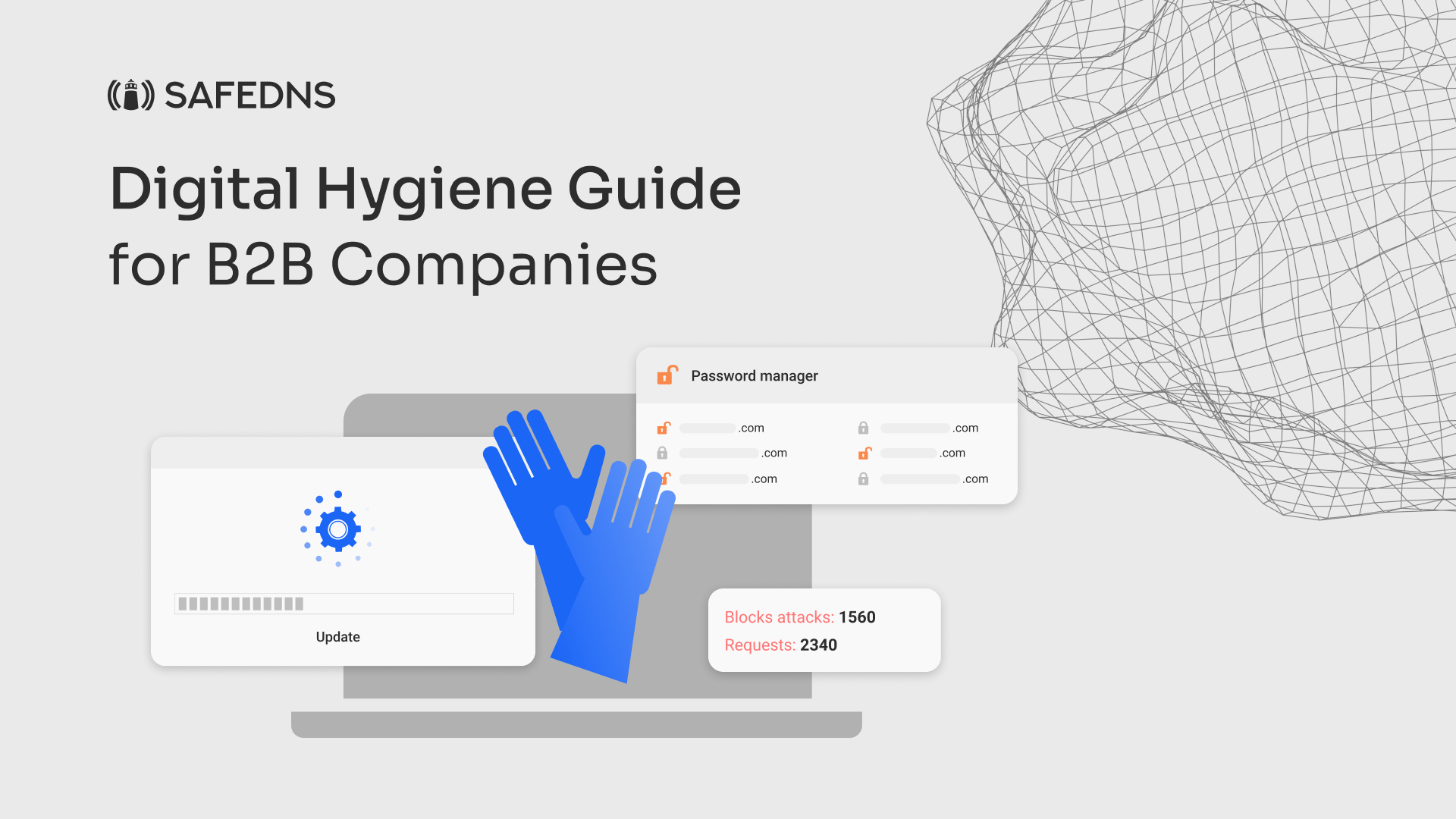
Digital Hygiene Guide for B2B Companies
\With cyber threats becoming highly sophisticated, it is important for organizations to maintain a strong defense against potential attacks. As cybersecurity experts, we at SafeDNS understand the value and significance of digital hygiene for businesses. Today we will explore three key lines of defense in cybersecurity and review rules that B2B companies must implement to ensure a safe and secure online environment.
Good digital hygiene is the proactive approach that B2B companies must adopt to ensure the cleanliness, security, and overall well-being of their digital assets, data, and online activities across multiple platforms. In the fast-paced world of B2B interactions, it's extremely important to recognize that the vast majority of business operations now take place in the digital realm. Fundamental ways to maintain good digital hygiene include data security measures, online reputation management strategies, and compliance with industry regulations. By prioritizing these aspects, B2B companies can protect themselves from cyber threats, build trust among clients and partners, maintain a positive brand image, and ensure the efficient functioning of their digital operations.
The first line of defense is password and confidential data security. To ensure the basis of data hygiene is solid, check to see if you have done all you should have done to keep your data safe.
- It is crucial to apply a strict policy that requires a certain minimum password length and complexity for any account.
- Using different accounts and passwords to access different resources and utilizing multi-factor authentication are essential steps to enhance digital hygiene.
- Default credentials must be changed for equipment within the network, e.g., admin:admin.
- Provide each employee with their own accounts with strictly defined access rights to resources, especially when employees use the same workplace and device. Try to minimize user privileges whenever possible.
- Probably the most obvious yet problematic point: stop storing sensitive information in the clear or in the public domain!
- Regular backups are our everything: create backup copies of systems and store them on dedicated servers separate from the network segments of work systems. In the event of a cyberattack or data breach, having a reliable backup system and a well-defined disaster recovery plan is crucial.
- Key lesson to learn: work to increase employee awareness of data security. The more seriously you take this point, the fewer problems you will encounter.
The second defense line, the one you should take most seriously, is your technical means. To be sure that no threat can cross this line, we recommend you use:
- automated tools for security analysis and identification of software vulnerabilities;
- web application firewalls as a primary measure to protect web resources;
- systems for in-depth analysis of network traffic, which help detect complex targeted attacks both in real time and in saved copies of traffic;
- specialized anti-DdoS services;
- anti-virus protection systems with a sandbox, a built-in isolated environment, for dynamic file scanning, capable of identifying and blocking malicious files in corporate email before they are opened by employees;
- SIEM solutions: for timely detection and effective response to information security incidents.
The last line is system security. What can be done to ensure the security of this line of defense? Let’s have a look at the ways of protection.
- We strongly recommend that you conduct regular penetration tests to timely identify new attack vectors on internal infrastructure and evaluate the effectiveness of the protection measures taken.
- Also, it is important to analyze the security of web applications regularly, including source code analysis, in order to identify and eliminate vulnerabilities to attacks, including on application clients.
- Monitor the number of requests to resources per second and set up the configuration of servers and network devices in such a way as to neutralize typical attack scenarios (e.g., TCP and UDP floods or multiple requests to DB).
- Promptly update the software you use as patches are released.
- Control the appearance of unsafe resources on the network perimeter; regularly conduct an inventory of resources available for connection from the Internet; analyze the security of such resources; and eliminate vulnerabilities in the software used.
- Do not forget about filtering! It is crucial for your company’s web security to use content and email filtering to protect against phishing sites, resources that distribute viruses, DNS spoofing, and hidden miners.
Remember, digital hygiene is an ongoing process that requires constant vigilance. Implementing the practices mentioned above is a great start, but it is also essential to stay updated on the increasing number of threats and adapt your security measures accordingly.
By prioritizing digital hygiene and implementing proactive security measures, B2B companies can minimize the risk of cyberattacks, protect sensitive business data, and build trust among clients and partners, which is fundamental in today's world.
Invest in your company's digital hygiene and overall health today and safeguard your business against the ever-evolving threat landscape!
Take advantage of the SafeDNS trial period and try all the best features

